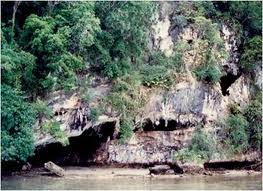Tabon Cave—Home of the Earliest Pinoys
Located in a large limestone formation
35 meters above sea level in Lipuun Point in Quezon, Palawan, the Tabon Caves
complex is one of the most important and well-known archaeological sites not
only in the country but in the whole Southeast Asia as well. Around 200 smaller
caves make up the Tabon Caves complex. The main cave, called the Tabon Cave (named
after a bird that digs its nest into the ground), has a mouth that measures 16
meters wide and 8 meters high. It measures nearly 48 meters long.
H. Otley Beyer was the first to note
the value of Palawan in the search for prehistoric humans in the country.
Following this, a team from the National Museum of the Philippines, led by Dr.
Robert Fox, discovered and explored hundreds of caves and rock shelters in the
province between 1962 and 1966.
Found in the caves were many artifacts,
including animal and fossilized human remains that prove the existence of
prehistoric life in the archipelago. The fossils in the caves are possibly the
earliest evidence of Homo sapiens’ habitation in Southeast Asia. Archaeological
excavation results in the Tabon Cave reveal evidence of continued prehistoric
human occupation over different periods that range from 8,500-30,500 years ago,
about the time of the Old Stone Age in the archipelago.
Among the fossil evidence found were: tibia (lower leg bone) fragment, mandible
(jawbone), frontal bone, and skullcap. These remains are from possibly the
oldest Homo sapiens in Southeast Asia. These human remains, dated to be about
22,000 to 24,000 years old, belonged to the earliest known human inhabitants of
the archipelago. One fossil (the tibia),
is the oldest human fossil so far recovered from the Tabon Cave; the fossil
dates back to 47,000 years (45,000 BC).
The cave complex also yielded flaked
stone tools and other tools common during the Pleistocene Era (1.6 million to
10,000 years ago). Other cultural materials found were jar burials, estimated
to have appeared during the late Neolithic, and continued on to the Metal Age.
Porcelains and stoneware, which shows evidence of local trade with China during
the Song and Yuan Dynasties, were also discovered in the caves. There were also
bones of elephants, giant tortoises, wild boars, deer, and other animals. All
these excavations show the more than 50,000 years of Philippine prehistory, as
well as early relations with south and East Asian countries.
The Tabon Caves today sits atop a cliff
overlooking the South China Sea. At the time of the occupation of these caves
(8,500-50,000 years ago, during the last glacial period), the environment
around the cave was very different; the seacoast was about thirty kilometers
away from the caves. People who occupied these caves may have made foraging
trips to the sea to fish and gather mollusks, but they did not bring their
catch back: archaeologists did not find any sign of seashells in the cave
floor. As evidenced by the animal
remains and the stone tools, the people who occupied these caves were mainly
hunters. The sea reached its present level only about 6,000 years ago, when the
caves were no longer inhabited.
There are 29 explored caves in the
Tabon Cave complex, which the National Museum maintain and manage.
Only one, however, is open to the
public.






Comments
Post a Comment
So, what do you think? Post it here: